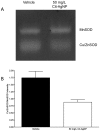Mechanism of silver nanoparticles action on insect pigmentation reveals intervention of copper homeostasis
- PMID: 23308159
- PMCID: PMC3538783
- DOI: 10.1371/journal.pone.0053186
Mechanism of silver nanoparticles action on insect pigmentation reveals intervention of copper homeostasis
Abstract
Silver nanoparticles (AgNPs), like almost all nanoparticles, are potentially toxic beyond a certain concentration because the survival of the organism is compromised due to scores of pathophysiological abnormalities past that concentration. However, the mechanism of AgNP toxicity remains undetermined. Instead of applying a toxic dose, we attempted to monitor the effects of AgNPs at a nonlethal concentration on wild type Drosophila melanogaster by exposing them throughout their development. All adult flies raised in AgNP doped food showed that up to 50 mg/L concentration AgNP has no negative influence on median survival; however, these flies appeared uniformly lighter in body color due to the loss of melanin pigments in their cuticle. Additionally, fertility and vertical movement ability were compromised due to AgNP feeding. Determination of the amount of free ionic silver (Ag(+)) led us to claim that the observed biological effects have resulted from the AgNPs and not from Ag(+). Biochemical analysis suggests that the activity of copper dependent enzymes, namely tyrosinase and Cu-Zn superoxide dismutase, are decreased significantly following the consumption of AgNPs, despite the constant level of copper present in the tissue. Consequently, we propose a mechanism whereby consumption of excess AgNPs in association with membrane bound copper transporter proteins cause sequestration of copper, thus creating a condition that resembles copper starvation. This model also explains the cuticular demelanization effect resulting from AgNP since tyrosinase activity is essential for melanin biosynthesis. Finally, we claim that Drosophila, an established genetic model system, can be well utilized for further understanding of the biological effects of nanoparticles.
Conflict of interest statement
Figures






References
-
- Woodrow Wilson International Center for Scholars. Nanotechnology Consumer Products Inventory,Washington, DC 2006; Available from http://www.nanotechproject.org/inventories/consumer/.
-
- Lee HY, Park HK, Lee YM, Kim K, Park SB (2007) A practical procedure for producing silver nanocoated fabric and its antibacterial evaluation for biomedical applications. Chem Commun (Camb) 28: 2959–2961. - PubMed
-
- Nel A, Xia T, MAdler N, Li N (2006) Toxic potential of materials at the nanolevel. Science 311: 622–627. - PubMed
-
- Vigneshwaran N, Kathe AA, Varadarajn PV, Nacahne RP, Balasubramanya RH (2007) Functional finishing of cotton fabrics using silver nanoparticles. J Nanosci Nanotechnol 7: 1893–1907. - PubMed
Publication types
MeSH terms
Substances
LinkOut - more resources
Full Text Sources
Other Literature Sources
Molecular Biology Databases
Miscellaneous

